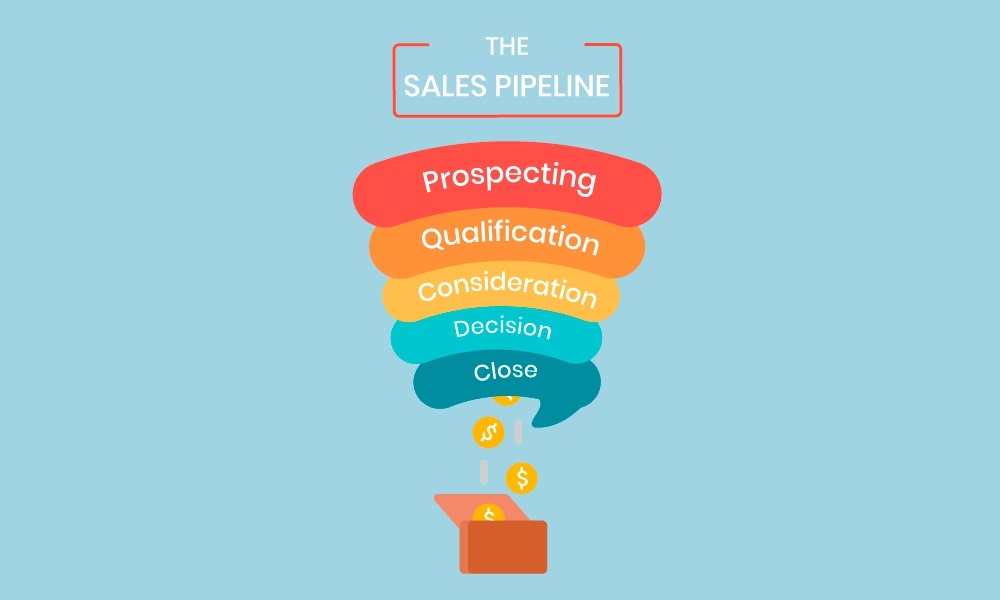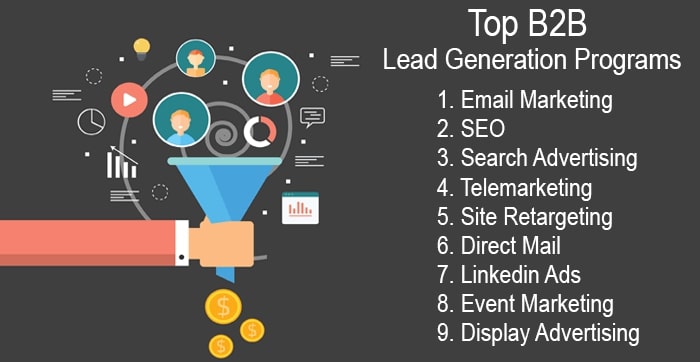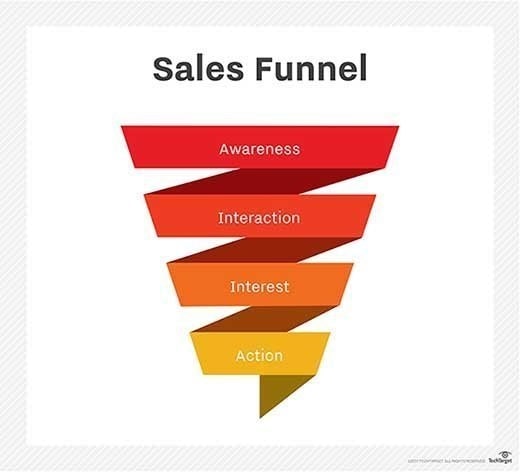To anyone who’s worked in sales or marketing, the differences between a sales pipeline and a sales funnel are likely well known. But if you’ve never come across the two concepts before, you may well be wondering what the differences are; after all, both concepts sound pretty similar.
While there are similarities between the two, there are also some subtle but key differences, and in this article, we’ll define both terms, take a deeper look at both of them and dive into the differences between the two.
Let’s get started.
Table of Contents:
- What is a sales pipeline?
- What is a sales funnel?
- The differences between a sales pipeline and a sales funnel
- Wrapping it up
What is a sales pipeline?
A sales pipeline is a series of stages a prospective customer or lead moves through as they progress from being a prospective customer to a paying one. Sales pipelines are usually used internally by sales teams to track the different stages that prospects take on their way to becoming a buyer/customer.

Prospects are moved from one stage to the next as they move through a company’s sales process, usually dependent on actions taken by a salesperson.
Typically, a sales team will have a $ value attached to their own individual and team’s sales pipelines. The pipeline will display the deals that a sales team currently has open, the status of these deals, the expected close date of these open deals, the leads that the sales team has contacted, and information on the deals that have fallen through.
Here are the key stages of a sales pipeline:
Lead generation – This is when sales and marketing teams will work together to discover new leads and prospective customers for their business. Most businesses have multiple ways of getting their leads, and they’ll know the type of potential customer they’re looking to attract. Some of the most popular methods are a mixture of inbound and outbound marketing methods, such as pay-per-click advertising, word of mouth/referral marketing, email marketing, SEO, cold calling, and social media prospecting on platforms like LinkedIn.

Qualification – Qualifying new prospects involves a business; usually, the business’s sales team qualifies the prospects they’ve sourced through their lead generation efforts to see if a prospect is a good fit for the product or service they’re selling. This process can involve a salesperson checking to see what industry a prospect is in, what solution they’re looking for, and what their budget is.
In addition, a salesperson will often ask the potential customer a series of questions. The interaction may occur online, over the phone, on a virtual call, or in person.
Some of the typical questions a salesperson may ask a prospect are:
- What problem are you looking to solve?
- Have you tried to solve the problem before, and if so, what solutions have you previously used?
- How much do you know about the product/solution?
- What budget do you have available?
- What’s prompting you to take action to solve this problem?
- Do you have a time frame in which you need to solve this problem?
These questions work well at determining whether the prospect has the budget for the product or service the business is selling and whether the solution they are selling is suitable for the prospect.
Meeting/demonstration – After qualifying a prospect, a salesperson will then show or discuss the product/service with the prospect in more detail and discuss the finer points of the solution. If the prospect decides the solution is right for them, the salesperson will usually begin putting a business proposal together.
Proposal – If the prospect agrees to purchase the solution, the salesperson will then send a proposal to the prospect. This proposal will contain the price of the solution/service, the length of the contract (if required), the terms of the agreement, and the level of service included.
The deal is closed or lost – If the prospect accepts the proposal, financial negotiations can begin. If the prospect and the sales rep sign the contract, the prospect becomes a customer. But, if the proposal is declined, the sales opportunity is lost. Often the salesperson will contact the prospect again in the future to try and resurrect the deal if they decline the initial proposal.
Retention – The retention stage is the extra, final step applicable after the deal is closed. This stage is often left out of sales pipeline representations, but it shouldn’t be. Customer loyalty and retention should be considered a vital part of the sales process. Usually, responsibility for customer retention will shift away from the sales team and towards the customer service/client services teams.

What is a sales funnel?
A sales funnel is a marketing concept that represents each step a prospect takes on the road to becoming a customer. While this definition is very similar to the definition we’ve used to describe a sales pipeline, there is a key difference.
Instead of being business or brand focussed, a sales funnel is customer-focused in the way that it describes and represents the various stages a customer goes on during their journey to making a purchase, with each stage defined by how ‘aware’ a prospect is of a solution and their level of purchasing intent.
When a marketing team knows what stage of awareness a prospect is in, they can tailor their marketing activities accordingly. For example, if they know that a prospect has looked at their website, read a couple of blog posts about a particular topic, or joined their email list the marketing team can be confident that the prospect knows what their brand provides and is open to hearing about the businesses solutions and products that are relevant to the blog posts and web pages they have looked at.
A typical sales funnel is made of up various stages, these are:
The Awareness stage – The first stage of a sales funnel is known as the awareness stage. As the name suggests, a prospect enters this stage when they become aware of a product or service. When becoming aware of a product/service, prospects are likely experiencing a specific problem and are searching for different solutions to that problem.
A prospect may hear about a solution through a Google search, word of mouth, a review website, social media, or another source. This is the stage with the largest number of prospects.
The Interest stage – This is the stage when a prospect develops an interest in a specific solution or set of solutions that can solve their problem.
For example, let’s say you want to move house. You know you have a problem (you don’t like where you currently live), you’ve started looking at different houses online and found some that you like, so you’re aware of potential solutions to your problem, and you’ve now shortlisted five places that you’ve requested more information on (you’ve reached the interest stage).
The Consideration stage – After a prospect has conducted thorough research into different solutions, they’ll begin to get more specific with their search and begin actively considering the different solutions they’ve looked at.
For example, a prospect may start looking at your different packages and their pricing to determine whether they can afford your solution. They may start reading a company’s testimonials, reviews, or case studies to see what others are saying about their products and to see how a company has helped other customers that are in a similar position to themselves.
If they’re considering numerous solutions, they’ll likely go through this process for each product, particularly if the solutions they’re considering have a high price point.
If we use the example of you wanting to move house again, this would be the stage when you have the information you’ve requested about the properties you’re interested in, and you’re looking at the specs of each property, maybe even visiting them to see which one you ultimately want to buy.
If you are selling physical products that need to be delivered, a lot of customers will also take a look at your return and refund policies. Make sure you have an updated return and refund policy page on your website so that this information is easily accessible.
The Decision stage – Once a prospect has evaluated the solutions they’re considering in detail and has decided; they’re officially in the decision stage. At this point, a prospect has assessed the problem they need to solve and decided upon the best solution that they think will best suit their needs.
Using the example of buying a house again, you’ve reached the decision stage when you’ve looked around the houses you were interested in, assessed each house in detail, and decided on the one you want to buy.
What are the differences between a sales pipeline and a sales funnel?
The stages in a sales pipeline are similar to those in a sales pipeline, with the key difference being in how they are presented. Sales pipelines can communicate the quantity or size of the potential deal, a deal’s total value, and the stage an open deal is at.
On the other hand, sales funnels indicate how prospects are finding a business and enable marketing teams to track how many prospects are moving down the funnel.
Another difference (one that we mentioned earlier) is that a sales pipeline is focused on a business’s activity and its efforts to generate leads and discover whether they are the right fit for what they’re selling. A sales funnel focuses on the prospect’s journey, how they discover a business and how they gradually move closer to making a purchase.
In other words, a sales pipeline represents the process sales teams use to turn a prospect into a customer. In contrast, a sales funnel represents the purchasing journey from the perspective of the customer.
A business can use a sales pipeline to measure how effective its sales process is. For example, as we mentioned earlier, most sales teams track how many qualified prospects they are interacting with and getting interest from, how many meetings or demos they are giving, how many proposals they’re sending out, and how many deals they are winning.
Whereas a marketing team can use a sales funnel to record how prospects find their business and what marketing channels prospects are using to find their business. This information helps marketing teams see whether their budget is being spent productively, see whether they could save money and whether their marketing efforts are paying off.
For example, if an HR company’s marketing team’s monthly target is thirty new leads, but they’re bringing in fifty leads per month and their sales funnel reporting informs them that the majority of those leads are finding the business through search engines, then the marketing team will know that they have an effective SEO strategy in place.
Sales funnel reporting should also give marketing and sales teams an indication of how a channel is converting. If a channel is not getting them the conversions they are aiming for; they may need to reconsider their approach to that specific channel.
For instance, if a company’s website is not bringing in the traffic that it should be then its conversion rates will suffer. To combat this the company could ask its team to invest some time focusing on getting a few SEO certifications to improve their skills.
Or, if a company isn’t getting enough of their emails delivered to newsletter subscribers, they could switch to one of the many cheap email marketing services that are available as options and also invest in email copywriting training.
Wrapping it up
Most businesses will use some form of sales pipeline and sales funnel even if they’re not entirely conscious of the two concepts. Sales teams can use sales pipelines to monitor how their deals are progressing and how each salesperson is performing. They can use this information to refine their sales process, improve their lead generation activities, and predict how much revenue their sales team can expect to bring in.
Sales funnels give sales and marketing teams key insights into how prospects find their business, how many of those prospects are converting and can uncover any areas of their sales and marketing strategy that need improvement.
If companies can use these two concepts effectively, they can effectively track their sales activities, make informed predictions about how much revenue they expect to generate, and uncover areas of their business that need improvement.
Mention is a tool that helps brands tap further into valuable insights from their audience. You can learn more about Mention here.






